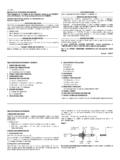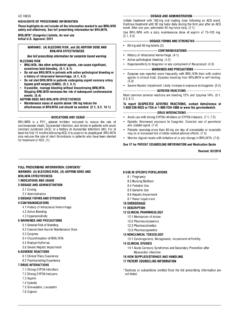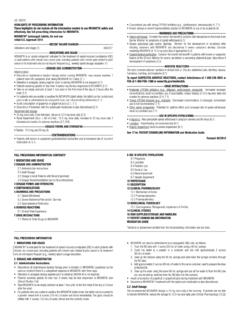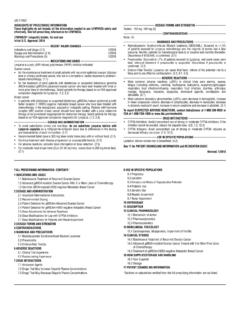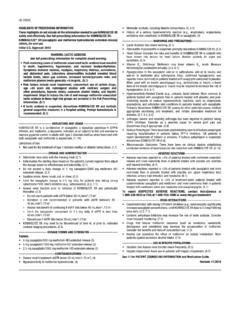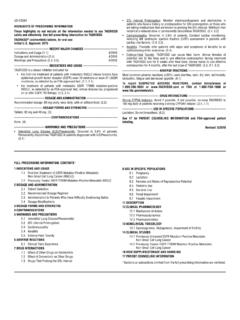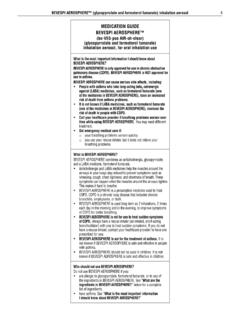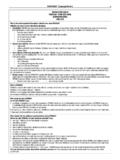Transcription of HIGHLIGHTS OF PRESCRIBING INFORMATION …
1 US-16912 HIGHLIGHTS OF PRESCRIBING INFORMATION These HIGHLIGHTS do not include all the INFORMATION needed to use QTERN safely and effectively. See full PRESCRIBING INFORMATION for (dapagliflozin and saxagliptin) tablets, for oral use Initial Approval: 2017------------------------------- INDICATIONS AND USAGE -------------------------------QTERN is a sodium-glucose cotransporter 2 (SGLT-2) inhibitor and a dipeptidyl peptidase-4 (DPP-4) inhibitor combination product indicated as an adjunct to diet and exercise to improve glycemic control in adults with type 2 diabetes mellitus (T2DM) who have inadequate control with dapagliflozin or who are already treated with dapagliflozin and saxagliptin. (1, 14)Limitations of Use: Is not indicated for the treatment of type 1 diabetes mellitus or diabetic ketoacidosis. (1) Should only be used in patients who tolerate 10 mg dapagliflozin.
2 (1)--------------------------- DOSAGE AND ADMINISTRATION ---------------------------The recommended dose of QTERN is a 10 mg dapagliflozin/5 mg saxagliptin tablet taken orally once daily in the morning with or without food. ( ) Assess renal function before initiation of therapy and periodically thereafter. Do not initiate QTERN if eGFR is below 60 mL/ m2. ( ) Discontinue QTERN if eGFR falls persistently below 60 mL/ m2. ( ) Do not coadminister QTERN with strong cytochrome P450 3A4/5 inhibitors. ( , ) Tablet should be swallowed whole and not be split or DOSAGE FORMS AND STRENGTHS -------------------------Tablet: 10 mg dapagliflozin/5 mg saxagliptin (3)--------------------------------- CONTRAINDICATIONS ---------------------------------QTERN is contraindicated in patients with: History of a serious hypersensitivity reaction to dapagliflozin or to saxagliptin, such as anaphylaxis, angioedema, or exfoliative skin conditions.
3 (4, , ) Moderate to severe renal impairment (eGFR <45 mL/ m2), end-stage renal disease (ESRD), or patients on dialysis. (4)--------------------------- WARNINGS AND PRECAUTIONS ----------------------------Pancreatitis : If pancreatitis is suspected, promptly discontinue QTERN. ( , )Heart Failure: Consider the risks and benefits of QTERN in patients who have known risk factors for heart failure. Monitor patients for signs and symptoms. ( )Hypotension: Before initiating QTERN, assess volume status and correct hypovolemia in the elderly, in patients with renal impairment or low systolic blood pressure, and in patients on loop diuretics. Monitor for signs and symptoms during therapy. ( , )Ketoacidosis: Assess patients who present with signs and symptoms of metabolic acidosis for ketoacidosis regardless of blood glucose level.
4 If suspected, discontinue QTERN, evaluate and treat promptly. Before initiating QTERN, consider risk factors for ketoacidosis. Patients on QTERN may require monitoring and temporary discontinuation of therapy in clinical situations known to predispose to ketoacidosis. ( , )Acute Kidney Injury and Impairment in Renal Function: Consider temporarily discontinuing in settings of reduced oral intake or fluid losses. If acute kidney injury occurs, discontinue and promptly treat. Monitor renal function during therapy. ( , )Urosepsis and Pyelonephritis: Evaluate for signs and symptoms of urinary tract infections and treat promptly, if indicated. ( , )Hypoglycemia: Consider lowering the dose of insulin secretagogue or insulin to reduce the risk of hypoglycemia when initiating QTERN. ( , )Hypersensitivity Reactions ( , urticaria, facial edema): There have been postmarketing reports of serious hypersensitivity reactions treated with saxagliptin, such as anaphylaxis, angioedema, and exfoliative skin conditions.
5 Promptly discontinue QTERN, assess for other potential causes, institute appropriate monitoring and treatment, and initiate alternative treatment for diabetes. ( , )Genital Mycotic Infections: Monitor and treat if indicated. ( , )Increased LDL C: Monitor and treat per standard of care. ( , )Bladder Cancer: An imbalance in bladder cancers was observed in clinical studies with dapagliflozin. QTERN should not be used in patients with active bladder cancer and should be used with caution in patients with a prior history of bladder cancer. ( )Arthralgia: Severe and disabling arthralgia has been reported in patients taking DPP-4 inhibitors. Consider as a possible cause for severe joint pain and discontinue drug if appropriate. ( , , )Bullous Pemphigoid: There have been postmarketing reports of bullous pemphigoid requiring hospitalization in patients taking DPP-4 inhibitors.
6 Tell patients to report development of blisters or erosions. If bullous pemphigoid is suspected, discontinue QTERN. ( )Macrovascular Outcomes: There have been no clinical studies establishing conclusive evidence of macrovascular risk reduction with QTERN. ( )--------------------------------- ADVERSE REACTIONS ---------------------------------Adverse reactions reported in 5% of subjects treated with 10 mg dapagliflozin and 5 mg saxagliptin were: upper respiratory tract infection, urinary tract infection, and dyslipidemia. ( )To report SUSPECTED ADVERSE REACTIONS, contact AstraZeneca at 1-800-236-9933 or FDA at 1-800-FDA-1088 or DRUG INTERACTIONS ---------------------------------Strong CYP3A4/5 Inhibitors ( , Ketoconazole): Do not coadminister QTERN with strong cytochrome P450 3A4/5 inhibitors. ( , )--------------------------- USE IN SPECIFIC POPULATIONS ----------------------------Pregnancy: Advise females of the potential risk to a fetus especially during the second and third trimesters.
7 ( )Lactation: QTERN is not recommended when breastfeeding. ( )Geriatrics: Higher incidence of adverse reactions related to volume depletion and reduced renal function. ( , , )Renal Impairment: Higher incidence of adverse reactions related to reduced intravascular volume and renal function. ( , , )See 17 for PATIENT COUNSELING INFORMATION and Medication GuideRevised: 02/2017 FULL PRESCRIBING INFORMATION : CONTENTS*1 INDICATIONS AND USAGE2 DOSAGE AND ADMINISTRATION Dosage Patients with Renal Impairment Use with Strong CYP3A4/5 Inhibitors3 DOSAGE FORMS AND STRENGTHS4 CONTRAINDICATIONS5 WARNINGS AND PRECAUTIONS Pancreatitis Heart Failure Hypotension Ketoacidosis Acute Kidney Injury and Impairment in Renal Function Urosepsis and Pyelonephritis Hypoglycemia with Concomitant Use of Insulin or Insulin Secretagogues Hypersensitivity Reactions Genital Mycotic Infections Increases in Low-Density Lipoprotein Cholesterol (LDL C) Bladder Cancer Severe and Disabling Arthralgia Bullous Pemphigoid Macrovascular Outcomes6 ADVERSE REACTIONS Clinical Trials Experience Postmarketing Experience7 DRUG INTERACTIONS Strong Inhibitors of CYP3A4/5 Enzymes Positive Urine Glucose Test Interference with 1,5-anhydroglucitol (1,5-AG)
8 Assay8 USE IN SPECIFIC POPULATIONS Pregnancy Lactation Pediatric Use Geriatric Use Patients with Renal Impairment Patients with Hepatic Impairment10 OVERDOSAGE11 DESCRIPTION12 CLINICAL PHARMACOLOGY Mechanism of Action Pharmacodynamics Pharmacokinetics13 NONCLINICAL TOXICOLOGY Carcinogenesis, Mutagenesis, Impairment of Fertility Animal Toxicology and/or Pharmacology14 CLINICAL STUDIES Add-on Therapy with Saxagliptin in Patients on Dapagliflozin plus Metformin Cardiovascular Safety Trial16 HOW SUPPLIED/STORAGE AND HANDLING17 PATIENT COUNSELING INFORMATION *Sections or subsections omitted from the full PRESCRIBING INFORMATION are not PRESCRIBING INFORMATION1 INDICATIONS AND USAGEQTERN (dapagliflozin and saxagliptin) is indicated as an adjunct to diet and exercise to improve glycemic control in adults with type 2 diabetes mellitus (T2DM) who have inadequate control with dapagliflozin or who are already treated with dapagliflozin and saxagliptin [see Clinical Studies (14)].
9 Limitations of UseQTERN is not indicated for the treatment of type 1 diabetes mellitus or diabetic should only be used in patients who tolerate 10 mg DOSAGE AND DosageIn patients with volume depletion, correct this condition prior to initiation of QTERN [see Warnings and Precautions ( ), and Use in Specific Populations ( , )].The recommended dose of QTERN is a 10 mg dapagliflozin/5 mg saxagliptin tablet taken orally once daily in the morning with or without food. Do not split or cut QTERN Patients with Renal Impairment Assessment of renal function is recommended prior to initiation of QTERN therapy and periodically not initiate QTERN in patients with an estimated glomerular filtration rate (eGFR) below 60 mL/ QTERN if eGFR falls persistently below 60 mL/ m2 [see Warnings and Precautions ( ) and Use in Specific Populations ( )].
10 QTERN is contraindicated in patients with an eGFR less than 45 mL/ m2 [see Contraindications (4)]. Use with Strong CYP3A4/5 Inhibitors Do not coadminister QTERN with strong cytochrome P450 3A4/5 inhibitors ( , ketoconazole, atazanavir, clarithromycin, indinavir, itraconazole, nefazodone, nelfinavir, ritonavir, saquinavir, and telithromycin) [see Drug Interactions ( )].3 DOSAGE FORMS AND STRENGTHS QTERN tablets containing 10 mg dapagliflozin and 5 mg saxagliptin are light brown to brown, biconvex, round, film-coated, with 1122 printed on both sides of the tablet, in blue CONTRAINDICATIONS QTERN is contraindicated in patients with: History of a serious hypersensitivity reaction to dapagliflozin or to saxagliptin, including anaphylaxis, angioedema or exfoliative skin conditions [see Warnings and Precautions ( ) and Adverse Reactions ( )]. Moderate to severe renal impairment (eGFR less than 45 mL/ m2), end-stage renal disease (ESRD), or patients on dialysis [see Use in Specific Populations ( )].
